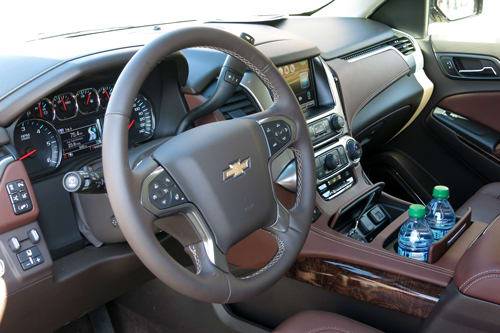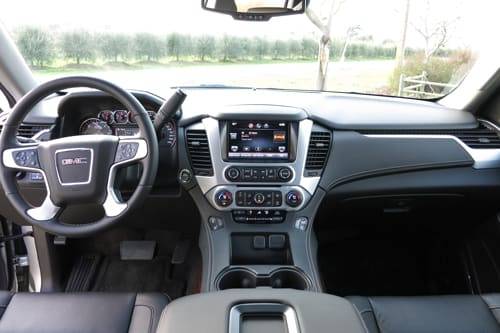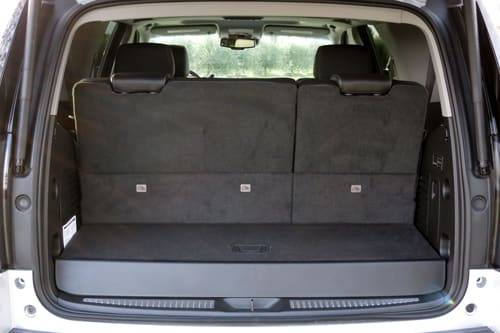2015 Chevrolet Tahoe, GMC Yukon: First Drive


If I had to choose one word to describe GM’s redesigned full-size SUVs, it would be refinement. From the way they drive to how their interiors are finished, these truck-based SUVs are anything but truck-like.
2015 Chevrolet Tahoe: More Photos
I traveled to Northern California to spend a day driving the 2015 Chevrolet Tahoe and GMC Yukon on a mix of winding mountain roads, urban freeways and city streets to see how they perform. If they’re not already on your local dealer’s lot, they should be arriving soon.
The first thing you notice about these SUVs is how quiet they are. It’s easy to carry a conversation with front and backseat passengers at highway speeds because wind noise is nearly nonexistent. GM says the SUVs’ new inlaid-door design helps keep wind noise low, but noise from other cars and trucks isn’t bothersome, either. It’s so quiet, in fact, that I was surprised more than once by how fast I was traveling when I glanced down at the speedometer; there’s not the kind of ambient noise you normally associate with 55 or 75 mph.
These are big SUVs: They’re 17 feet long and 6.7 feet wide. Their size might be intimidating, but they’re actually really easy to drive. You sit up high with good forward views, and they track confidently without needing to constantly make minor steering corrections. The steering wheel feels a little numb, but the electrically assisted power-steering system offers predictable responses.
A few different suspensions are offered and I tested two of them: the Premium Smooth Ride Suspension on a Yukon SLT and GM’s Magnetic Ride Control in a Tahoe LTZ. Magnetic Ride Control features shock absorbers with variable damping properties and does an exceptional job controlling body roll, but I preferred the Yukon SLT’s suspension because it provides better ride comfort and keeps body motion in check nearly as well as Magnetic Ride Control.
Both the Tahoe and Yukon come standard with a 5.3-liter V-8 engine that makes 355 horsepower and 383 pounds-feet of torque; Yukon Denalis get a 420-hp, 6.2-liter V-8 with 460 pounds-feet of torque. The 5.3-liter V-8 and its six-speed automatic transmission work well together, readily accelerating these SUVs up to highway speeds and easily maintaining highway cruising speeds through hilly terrain.
Four-wheel-drive models like the ones I tested get an EPA-estimated 16/22/18 mpg city/highway combined. With rear-wheel drive, gas mileage increases slightly to 16/23/18 mpg. The 5.3-liter V-8 has a number of fuel-saving measures like direct fuel injection, variable valve timing and cylinder deactivation that automatically switches from V-8 to V-4 mode when less power is needed. With some cylinder-deactivation systems, like the one for Honda’s V-6 engine, you can feel a slight change in the engine when it deactivates cylinders, but I wasn’t able to notice it in the 5.3-liter V-8. It’s seamless. The only giveaway is an instrument panel indicator that shows whether the V-8 is using all or half of its cylinders.

The Tahoe’s interior (photo above) has high-grade finishes and design cues throughout, including lots of soft-touch panels, accent stitching and, on the Yukon (photo below), standard aluminum trim. It feels premium, which you’d expect from SUVs that both start at more than $45,000 including the destination charge. The front bucket seats are separated by a wide center console, but it doesn’t encroach on leg space because of the overall width of these SUVs. Center dashboard controls for the stereo and climate system are easy to reach and use.

The available second-row bucket seats — a split-folding bench seat is standard — are comfortable for adults. The seats are high enough off the floor, which helps thigh support, and legroom is good. They don’t slide forward or backward, but they do recline.
The third row is another story, at least for taller passengers (I’m 6-foot-1). The seat is close to the floor so you sit with your knees up in the air, and there’s not enough space for your legs behind the second-row seat. It’s uncomfortable.
Ford offers an adult-sized third row in its full-size Expedition SUV, which is enabled by packaging benefits that come with its independent rear suspension. Jeff Luke, GM’s executive chief engineer for full-size and midsize trucks, said an independent rear suspension was considered for the full-size SUVs, but they decided to use a live rear axle like past models so they could spend program money elsewhere.

Third-row configurability is one of the biggest benefactors of that decision as the seat now folds flat rather than having to be removed from the SUV and stored when more cargo space is needed. The cargo floor is about 3 feet off the ground, so loading luggage requires a big lift.
The Tahoe and Yukon might seem like another minivan-alternative for families, but GM says its research tells a different story, with only 35 percent of buyers having children at home. Mark Clawson, Chevrolet marketing manager for full-size SUVs, says the vehicle is bought more for image reasons, and that luxury sedans like the BMW 7 Series and Jaguar XJ are also in some customers’ garages. These SUVs don’t wear traditional luxury badges, but they’re as luxurious and refined as they’ve ever been.
Cars.com photos by Mike Hanley

Mike Hanley has more than 20 years of experience reporting on the auto industry. His primary focus is new vehicles, and he's currently a Senior Road Test Editor overseeing expert car reviews and comparison tests. He previously managed Editorial content in the Cars.com Research section.
Featured stories




